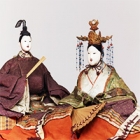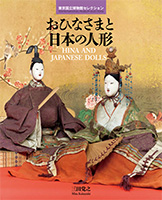Japanese Gallery (Honkan) Room 14
March 1, 2016 (Tue) - April 10, 2016 (Sun)
In Japan, the third day of the third month is the “Peach Blossom Festival” for young girls, the time to display festive hina dolls. The history of these dolls goes back to ancient times when people purified themselves by transferring “defilements” and “wrongdoings” to dolls, and also to the Heian period (794-1192) when aristocrats used dolls as protective charms for their children. These children also played house with small dolls.
The use of dolls for purification and for play continued into the Edo period (1603–1868), during which the tradition of displaying hina dolls for girls during the Peach Blossom Festival became established. Early hina are thought to have been standing paper dolls that were used mainly for play.
Moreover, special made-to-order sitting dolls in silk clothes were created for the imperial court from the first half of the 17th century, a practice which later spread to the warrior class and the townspeople. Dolls with costumes of ample silk and gold brocade were created particularly for wealthy townspeople.
This exhibition displays various dolls to trace this rich history. We ask visitors to give special attention to the best examples from our collection: gekubi bina and kokin bina, with the latter featuring ivory heads, arms, and legs. Combined with these ivory dolls is a model of a hall at the imperial court used for official ceremonies. It has been cleaned by conservators and is being exhibited for the first time.
All of the gosho ningyo dolls in our collection will also be displayed. These kind of dolls were loved by the imperial court and daimyo families, and are considered the finest example of Japanese doll-making because of their superb modeling. We hope that this exhibition will convey the delicacy, beauty, and charm of Japanese aesthetics.


